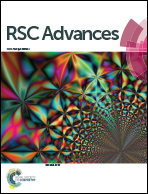Implementing thermally-excited-catalytic course solely using ambient heat motivation for efficient abatement of water pollutants†
Abstract
Interest in photocatalysis has been fascinated by the realization that solar light is effectively an inexhaustible energy resource. Nevertheless, the necessity for high-energy ultraviolet irradiation and excessive recombination of photogenerated electrons and holes have seriously restricted its evolution for industrial sized scales. Here we report on a thermally-excited-catalytic (TEC) design purely from leveraging ambient heat to completely decompose water pollutants. A-fabricated Cu/NiMn2O4 (CNM) with a thermally-sensitized feature possesses relatively high TEC activity that disassociates hazardous materials in the dark, suggesting successful uses catalyzing a broad range of chemical reactions with a degradation process. Additionally, a convincing explanation of a TEC decomposition mechanism is described from collecting the degradation products. Stability evaluation demonstrates that the morphology and structure of CNM remains unchanged even after multiple degradation use cycles, and hence this stable catalyst can be recovered and reused without appreciable loss in activity. Briefly, our evidence may attest to feasibility of a general concept for executing a TEC route through heat stimulus, offering a desirable way to effectively remove environmental contamination.


 Please wait while we load your content...
Please wait while we load your content...